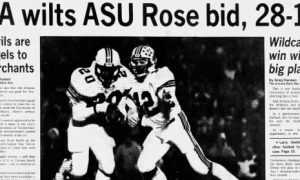[rps-paypal]
[ezcol_1half id=”” class=”” style=””]

— General history
— The games
— Comparisons then and now
— Wildcats nickname
— Military service
— Rankings
[/ezcol_1half]
[ezcol_1half_end id=”” class=”” style=””]
Excerpt from L.A. Times, Nov. 8, 1914, authored by Bill Henry:
“Arizona’s cactus-fed athletes, despite heroic efforts on the part of their two halfbacks, (Asa) Porter and (Franklin) Luis, went down to defeat before the Occidental Tigers yesterday afternoon, the tally with all precincts heard from being 14 to 0 in favor of the Tigers.
Confident of rolling up a big score, the Tigers took the field with grins on their faces, but before the game was 10 seconds old they knew they had a battle on their hands.
The Arizona men showed the fight of wild cats and displayed before the public gaze a couple of little shrimps in the backfield who defied all attempts of the Tigers to stop them.”This site will conduct a countdown in a 100-day period, leading up to Arizona’s 2014 football season-opener with UNLV on Aug. 29 at Arizona Stadium. The 100 Days ‘Til Kickoff countdown will include information daily about the historic 1914 Arizona team that helped create the school’s nickname of “Wildcats” because of how they played that fateful day against Occidental.
[/ezcol_1half_end]
[ezcol_1half id=”” class=”” style=””]
The Arizona Wildcats are scheduling as many as eight years in advance with news this week of their home-and-home arrangement with Southeastern Conference opponent Mississippi State in 2022 and 2023.
Back in 1914, Arizona Varsity coach and athletic director J.F. “Pop” McKale feverishly whipped together games in the days leading up to the season.
Because of time-and-distance logistics riding a train, and the infancy of the game, Arizona’s opponents consisted mostly of Indian schools and high schools from Arizona before 1914. The “Red and Blue”, as they were also called, played New Mexico and New Mexico State annually from 1910 to 1913. In 1905, the school traveled to California to play Pomona and Loyola.
[/ezcol_1half]
[ezcol_1half_end id=”” class=”” style=””]
[/ezcol_1half_end]
The Varsity did not return to California until nine years later for that fateful game against Occidental in 1914.
The riveting games against Occidental and Pomona that season prompted McKale to upgrade the schedule and continue to build excitement around the program.
“McKale quickly realized that the thing he had to do was to schedule some games with bigger schools in the area so Arizona could get a national reputation,” fullback Orville “Speedy” McPherson told Abe Chanin in the book They Fought Like Wildcats.
“He broke out of playing the town teams and the Indian schools.”

The 1914 Arizona football team that earned the honor of being named the first “Wildcats” was composed of (front row, left to right): Verne La Tourette, George Seeley, Leo Cloud, Richard Meyer, Asa Porter. Second row: Franklin Luis, Lawrence Jackson, Ray Miller, J.F. “Pop” McKale (coach), Turner Smith, Harry Hobson (manager), Orville McPherson, Albert Crawford, Ernest Renaud. Back row: Albert Condron, Emzy Lynch, Charley Beach, Vinton Hammels, Bill Hendry, George Clawson, Harry Turvey.
(AllSportsTucson.com graphic/Photo from University of Arizona Library Special Collections)
[ezcol_1half id=”” class=”” style=””]
The problem was McKale did not have much to choose from in that time in history.
College football in 1914 was comprised of independent teams trying to find opponents to complete no more than an eight-game schedule. Arizona only played five games, including one against the Douglas YMCA to start the season.
Only two conferences existed: The Big 9 and Missouri Valley Conference. The Big 9 was the beginning stages of the Big Ten and Missouri Valley included four modern-day Big 12 teams and Nebraska.
UCLA, Stanford and Cal did not field football teams in 1914. Stanford and Cal played rugby instead because of the physical dangers of football at that time. UCLA did not compete in football until 1919.
[/ezcol_1half]
[ezcol_1half_end id=”” class=”” style=””]
[/ezcol_1half_end]
The Pacific Coast Conference, the genesis of the Pac-12 today, began conference play in 1916 with Cal, Washington, Oregon and Oregon Agricultural College (now Oregon State). USC did not join until 1922, but the Trojans were still an attractive opponent for McKale.
“McKale quickly realized that the thing he had to do was to schedule some games with bigger schools in the area so Arizona could get a national reputation. He broke out of playing the town teams and the Indian schools.”
— Orville McPherson, Arizona fullback in 1914, as quoted in They Fought Like Wildcats
In 1916, McKale scheduled showcase games at Rice and against USC at Phoenix College. The Wildcats were outscored in those games 67-23 but Arizona gained more than it lost by making the sport more appealing to their players and fans.
The success Arizona had against powerhouse Occidental in 1914, when the school earned the nickname Wildcats in a hard-fought 14-0 loss, gave McKale the idea (and hope) Arizona could compete on a grander scale. That season (1914) and game Occidental (1914) meant a great deal to the evolution of football at Arizona beyond the nickname.
ALLSPORTSTUCSON.com publisher, writer and editor Javier Morales is a former Arizona Press Club award winner. He also writes articles for Bleacher Report and Lindy’s College Sports.




























